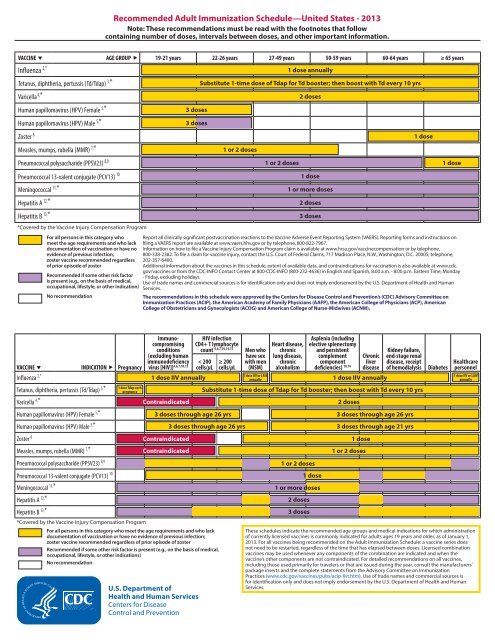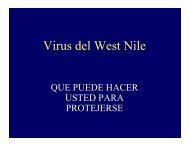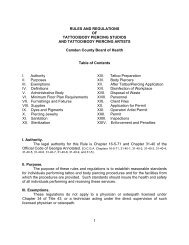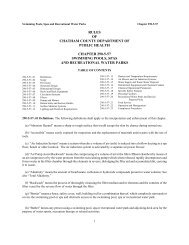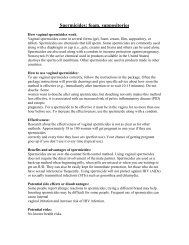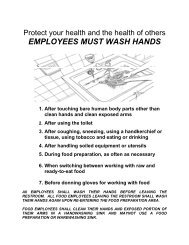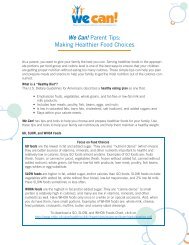2013 Adult Immunization Schedule - Student Health Services
2013 Adult Immunization Schedule - Student Health Services
2013 Adult Immunization Schedule - Student Health Services
You also want an ePaper? Increase the reach of your titles
YUMPU automatically turns print PDFs into web optimized ePapers that Google loves.
Recommended <strong>Adult</strong> <strong>Immunization</strong> <strong>Schedule</strong>—United States - <strong>2013</strong>Note: These recommendations must be read with the footnotes that followcontaining number of doses, intervals between doses, and other important information.VACCINE AGE GROUP 19-21 years 22-26 years 27-49 years 50-59 years 60-64 years ≥ 65 yearsInfluenza 2,*Tetanus, diphtheria, pertussis (Td/Tdap) 3,*Varicella 4,*Human papillomavirus (HPV) Female 5,*Human papillomavirus (HPV) Male 5,*Zoster 6Measles, mumps, rubella (MMR) 7,*Pneumococcal polysaccharide (PPSV23) 8,9Pneumococcal 13-valent conjugate (PCV13) 10Meningococcal 11,*Hepatitis A 12,*Hepatitis B 13,**Covered by the Vaccine Injury Compensation ProgramFor all persons in this category whomeet the age requirements and who lackdocumentation of vaccination or have noevidence of previous infection;zoster vaccine recommended regardlessof prior episode of zosterRecommended if some other risk factoris present (e.g., on the basis of medical,occupational, lifestyle, or other indication)No recommendation3 doses3 doses1 or 2 doses1 or 2 doses1 dose annuallySubstitute 1-time dose of Tdap for Td booster; then boost with Td every 10 yrs2 doses1 dose1 or more doses2 doses3 doses1 dose1 doseReport all clinically significant postvaccination reactions to the Vaccine Adverse Event Reporting System (VAERS). Reporting forms and instructions onfiling a VAERS report are available at www.vaers.hhs.gov or by telephone, 800-822-7967.Information on how to file a Vaccine Injury Compensation Program claim is available at www.hrsa.gov/vaccinecompensation or by telephone,800-338-2382. To file a claim for vaccine injury, contact the U.S. Court of Federal Claims, 717 Madison Place, N.W., Washington, D.C. 20005; telephone,202-357-6400.Additional information about the vaccines in this schedule, extent of available data, and contraindications for vaccination is also available at www.cdc.gov/vaccines or from the CDC-INFO Contact Center at 800-CDC-INFO (800-232-4636) in English and Spanish, 8:00 a.m. - 8:00 p.m. Eastern Time, Monday- Friday, excluding holidays.Use of trade names and commercial sources is for identification only and does not imply endorsement by the U.S. Department of <strong>Health</strong> and Human<strong>Services</strong>.The recommendations in this schedule were approved by the Centers for Disease Control and Prevention’s (CDC) Advisory Committee on<strong>Immunization</strong> Practices (ACIP), the American Academy of Family Physicians (AAFP), the American College of Physicians (ACP), AmericanCollege of Obstetricians and Gynecologists (ACOG) and American College of Nurse-Midwives (ACNM).VACCINE Influenza 2,*Tetanus, diphtheria, pertussis (Td/Tdap) 3,*Varicella 4,*Human papillomavirus (HPV) Female 5,*Human papillomavirus (HPV) Male 5,*Zoster 6Measles, mumps, rubella (MMR) 7,*Pneumococcal polysaccharide (PPSV23) 8,9INDICATION PregnancyPneumococcal 13-valent conjugate (PCV13) 10Meningococcal 11,*Hepatitis A 12,*Hepatitis B 13,*1 dose Tdap eachpregnancy*Covered by the Vaccine Injury Compensation ProgramImmunocompromisingconditions(excluding humanimmunodeficiencyvirus [HIV]) 4,6,7,10,15ContraindicatedContraindicatedContraindicatedHIV infectionCD4+ T lymphocytecount 4,6,7,10,14,15< 200cells/μL1 dose IIV annually≥ 200cells/μL3 doses through age 26 yrs3 doses through age 26 yrsFor all persons in this category who meet the age requirements and who lackdocumentation of vaccination or have no evidence of previous infection;zoster vaccine recommended regardless of prior episode of zosterRecommended if some other risk factor is present (e.g., on the basis of medical,occupational, lifestyle, or other indications)No recommendationMen whohave sexwith men(MSM)1 dose IIV or LAIVannuallyHeart disease,chroniclung disease,chronicalcoholism1 or 2 doses1 or more doses2 doses3 dosesAsplenia (includingelective splenectomyand persistentcomplementcomponentdeficiencies) 10,141 dose2 doses1 dose1 or 2 dosesChronicliverdisease1 dose IIV annuallyKidney failure,end-stage renaldisease, receiptof hemodialysisSubstitute 1-time dose of Tdap for Td booster; then boost with Td every 10 yrs3 doses through age 26 yrs3 doses through age 21 yrsDiabetes<strong>Health</strong>carepersonnel1 dose IIV or LAIVannuallyThese schedules indicate the recommended age groups and medical indications for which administrationof currently licensed vaccines is commonly indicated for adults ages 19 years and older, as of January 1,<strong>2013</strong>. For all vaccines being recommended on the <strong>Adult</strong> <strong>Immunization</strong> <strong>Schedule</strong>: a vaccine series doesnot need to be restarted, regardless of the time that has elapsed between doses. Licensed combinationvaccines may be used whenever any components of the combination are indicated and when thevaccine’s other components are not contraindicated. For detailed recommendations on all vaccines,including those used primarily for travelers or that are issued during the year, consult the manufacturers’package inserts and the complete statements from the Advisory Committee on <strong>Immunization</strong>Practices (www.cdc.gov/vaccines/pubs/acip-list.htm). Use of trade names and commercial sources isfor identification only and does not imply endorsement by the U.S. Department of <strong>Health</strong> and Human<strong>Services</strong>.
Footnotes — Recommended <strong>Immunization</strong> <strong>Schedule</strong> for <strong>Adult</strong>s Aged 19 Years and Older—United States, <strong>2013</strong>1. Additional information• Additional guidance for the use of the vaccines described in this supplement is available at http://www.cdc.gov/vaccines/pubs/acip-list.htm.• Information on vaccination recommendations when vaccination status is unknown and other general immunization information can befound in the General Recommendations on <strong>Immunization</strong> at http://www.cdc.gov/mmwr/preview/mmwrhtml/rr6002a1.htm.• Information on travel vaccine requirements and recommendations (e.g., for hepatitis A and B, meningococcal, and other vaccines) areavailable at http://wwwnc.cdc.gov/travel/page/vaccinations.htm.2. Influenza vaccination• Annual vaccination against influenza is recommended for all persons aged 6 months and older.• Persons aged 6 months and older, including pregnant women, can receive the inactivated influenza vaccine (IIV).• <strong>Health</strong>y, nonpregnant persons aged 2–49 years without high-risk medical conditions can receive either intranasally administered live,attenuated influenza vaccine (LAIV) (FluMist), or IIV. <strong>Health</strong>-care personnel who care for severely immunocompromised persons (i.e.,those who require care in a protected environment) should receive IIV rather than LAIV.• The intramuscularly or intradermally administered IIV are options for adults aged 18–64 years.• <strong>Adult</strong>s aged 65 years and older can receive the standard dose IIV or the high-dose IIV (Fluzone High-Dose).3. Tetanus, diphtheria, and acellular pertussis (Td/Tdap) vaccination• Administer one dose of Tdap vaccine to pregnant women during each pregnancy (preferred during 27–36 weeks’ gestation), regardlessof number of years since prior Td or Tdap vaccination.• Administer Tdap to all other adults who have not previously received Tdap or for whom vaccine status is unknown. Tdap can be administeredregardless of interval since the most recent tetanus or diphtheria-toxoid containing vaccine.• <strong>Adult</strong>s with an unknown or incomplete history of completing a 3-dose primary vaccination series with Td-containing vaccines shouldbegin or complete a primary vaccination series including a Tdap dose.• For unvaccinated adults, administer the first 2 doses at least 4 weeks apart and the third dose 6–12 months after the second.• For incompletely vaccinated (i.e., less than 3 doses) adults, administer remaining doses.• Refer to the Advisory Committee on <strong>Immunization</strong> Practices (ACIP) statement for recommendations for administering Td/Tdap asprophylaxis in wound management (see footnote #1).4. Varicella vaccination• All adults without evidence of immunity to varicella (as defined below) should receive 2 doses of single-antigen varicella vaccine or asecond dose if they have received only 1 dose.• Special consideration for vaccination should be given to those who have close contact with persons at high risk for severe disease (e.g.,health-care personnel and family contacts of persons with immunocompromising conditions) or are at high risk for exposure or transmission(e.g., teachers; child care employees; residents and staff members of institutional settings, including correctional institutions;college students; military personnel; adolescents and adults living in households with children; nonpregnant women of childbearingage; and international travelers).• Pregnant women should be assessed for evidence of varicella immunity. Women who do not have evidence of immunity should receivethe first dose of varicella vaccine upon completion or termination of pregnancy and before discharge from the health-care facility. Thesecond dose should be administered 4–8 weeks after the first dose.• Evidence of immunity to varicella in adults includes any of the following:——documentation of 2 doses of varicella vaccine at least 4 weeks apart;——U.S.-born before 1980 except health-care personnel and pregnant women;——history of varicella based on diagnosis or verification of varicella disease by a health-care provider;——history of herpes zoster based on diagnosis or verification of herpes zoster disease by a health-care provider; or——laboratory evidence of immunity or laboratory confirmation of disease.5. Human papillomavirus (HPV) vaccination• Two vaccines are licensed for use in females, bivalent HPV vaccine (HPV2) and quadrivalent HPV vaccine (HPV4), and one HPV vaccinefor use in males (HPV4).• For females, either HPV4 or HPV2 is recommended in a 3-dose series for routine vaccination at age 11 or 12 years, and for those aged13 through 26 years, if not previously vaccinated.• For males, HPV4 is recommended in a 3-dose series for routine vaccination at age 11 or 12 years, and for those aged 13 through 21 years,if not previously vaccinated. Males aged 22 through 26 years may be vaccinated.• HPV4 is recommended for men who have sex with men (MSM) through age 26 years for those who did not get any or all doses whenthey were younger.• Vaccination is recommended for immunocompromised persons (including those with HIV infection) through age 26 years for those whodid not get any or all doses when they were younger.• A complete series for either HPV4 or HPV2 consists of 3 doses. The second dose should be administered 1–2 months after the first dose;the third dose should be administered 6 months after the first dose (at least 24 weeks after the first dose).• HPV vaccines are not recommended for use in pregnant women. However, pregnancy testing is not needed before vaccination. If a womanis found to be pregnant after initiating the vaccination series, no intervention is needed; the remainder of the 3-dose series should bedelayed until completion of pregnancy.• Although HPV vaccination is not specifically recommended for health-care personnel (HCP) based on their occupation, HCP should receivethe HPV vaccine as recommended (see above).6. Zoster vaccination• A single dose of zoster vaccine is recommended for adults aged 60 years and older regardless of whether they report a prior episode ofherpes zoster. Although the vaccine is licensed by the Food and Drug Administration (FDA) for use among and can be administered topersons aged 50 years and older, ACIP recommends that vaccination begins at age 60 years.• Persons aged 60 years and older with chronic medical conditions may be vaccinated unless their condition constitutes a contraindication,such as pregnancy or severe immunodeficiency.• Although zoster vaccination is not specifically recommended for HCP, they should receive the vaccine if they are in the recommendedage group.7. Measles, mumps, rubella (MMR) vaccination• <strong>Adult</strong>s born before 1957 generally are considered immune to measles and mumps. All adults born in 1957 or later should have documentationof 1 or more doses of MMR vaccine unless they have a medical contraindication to the vaccine, or laboratory evidence of immunityto each of the three diseases. Documentation of provider-diagnosed disease is not considered acceptable evidence of immunity formeasles, mumps, or rubella.Measles component:• A routine second dose of MMR vaccine, administered a minimum of 28 days after the first dose, is recommended for adults who——are students in postsecondary educational institutions;——work in a health-care facility; or——plan to travel internationally.• Persons who received inactivated (killed) measles vaccine or measles vaccine of unknown type during 1963–1967 should be revaccinatedwith 2 doses of MMR vaccine.Mumps component:• A routine second dose of MMR vaccine, administered a minimum of 28 days after the first dose, is recommended for adults who——are students in a postsecondary educational institution;——work in a health-care facility; or——plan to travel internationally.• Persons vaccinated before 1979 with either killed mumps vaccine or mumps vaccine of unknown type who are at high risk for mumpsinfection (e.g., persons who are working in a health-care facility) should be considered for revaccination with 2 doses of MMR vaccine.Rubella component:• For women of childbearing age, regardless of birth year, rubella immunity should be determined. If there is no evidence of immunity,women who are not pregnant should be vaccinated. Pregnant women who do not have evidence of immunity should receive MMRvaccine upon completion or termination of pregnancy and before discharge from the health-care facility.HCP born before 1957:• For unvaccinated health-care personnel born before 1957 who lack laboratory evidence of measles, mumps, and/or rubella immunityor laboratory confirmation of disease, health-care facilities should consider vaccinating personnel with 2 doses of MMR vaccine at theappropriate interval for measles and mumps or 1 dose of MMR vaccine for rubella.8. Pneumococcal polysaccharide (PPSV23) vaccination• Vaccinate all persons with the following indications:——all adults aged 65 years and older;——adults younger than age 65 years with chronic lung disease (including chronic obstructive pulmonary disease, emphysema,and asthma); chronic cardiovascular diseases; diabetes mellitus; chronic renal failure; nephrotic syndrome; chronic liver disease(including cirrhosis); alcoholism; cochlear implants; cerebrospinal fluid leaks; immunocompromising conditions; and functionalor anatomic asplenia (e.g., sickle cell disease and other hemoglobinopathies, congenital or acquired asplenia, splenic dysfunction,or splenectomy [if elective splenectomy is planned, vaccinate at least 2 weeks before surgery]);——residents of nursing homes or long-term care facilities; and——adults who smoke cigarettes.• Persons with immunocompromising conditions and other selected conditions are recommended to receive PCV13 and PPSV23 vaccines.See footnote #10 for information on timing of PCV13 and PPSV23 vaccinations.• Persons with asymptomatic or symptomatic HIV infection should be vaccinated as soon as possible after their diagnosis.• When cancer chemotherapy or other immunosuppressive therapy is being considered, the interval between vaccination and initiationof immunosuppressive therapy should be at least 2 weeks. Vaccination during chemotherapy or radiation therapy should be avoided.• Routine use of PPSV23 is not recommended for American Indians/Alaska Natives or other persons younger than age 65 years unlessthey have underlying medical conditions that are PPSV23 indications. However, public health authorities may consider recommendingPPSV23 for American Indians/Alaska Natives who are living in areas where the risk for invasive pneumococcal disease is increased.• When indicated, PPSV23 should be administered to patients who are uncertain of their vaccination status and there is no record ofprevious vaccination. When PCV13 is also indicated, a dose of PCV13 should be given first (see footnote #10).9. Revaccination with PPSV23• One-time revaccination 5 years after the first dose is recommended for persons aged 19 through 64 years with chronic renal failure ornephrotic syndrome; functional or anatomic asplenia (e.g., sickle cell disease or splenectomy); and for persons with immunocompromisingconditions.• Persons who received 1 or 2 doses of PPSV23 before age 65 years for any indication should receive another dose of the vaccine at age 65years or later if at least 5 years have passed since their previous dose.• No further doses are needed for persons vaccinated with PPSV23 at or after age 65 years.10. Pneumococcal conjugate 13-valent vaccination (PCV13)• <strong>Adult</strong>s aged 19 years or older with immunocompromising conditions (including chronic renal failure and nephrotic syndrome), functionalor anatomic asplenia, CSF leaks or cochlear implants, and who have not previously received PCV13 or PPSV23 should receive a singledose of PCV13 followed by a dose of PPSV23 at least 8 weeks later.• <strong>Adult</strong>s aged 19 years or older with the aforementioned conditions who have previously received one or more doses of PPSV23 shouldreceive a dose of PCV13 one or more years after the last PPSV23 dose was received. For those that require additional doses of PPSV23,the first such dose should be given no sooner than 8 weeks after PCV13 and at least 5 years since the most recent dose of PPSV23.• When indicated, PCV13 should be administered to patients who are uncertain of their vaccination status history and there is no recordof previous vaccination.• Although PCV13 is licensed by the Food and Drug Administration (FDA) for use among and can be administered to persons aged 50 yearsand older, ACIP recommends PCV13 for adults aged 19 years and older with the specific medical conditions noted above.11. Meningococcal vaccination• Administer 2 doses of meningococcal conjugate vaccine quadrivalent (MCV4) at least 2 months apart to adults with functional aspleniaor persistent complement component deficiencies.• HIV-infected persons who are vaccinated also should receive 2 doses.• Administer a single dose of meningococcal vaccine to microbiologists routinely exposed to isolates of Neisseria meningitidis, militaryrecruits, and persons who travel to or live in countries in which meningococcal disease is hyperendemic or epidemic.• First-year college students up through age 21 years who are living in residence halls should be vaccinated if they have not received adose on or after their 16th birthday.• MCV4 is preferred for adults with any of the preceding indications who are aged 55 years and younger; meningococcal polysaccharidevaccine (MPSV4) is preferred for adults aged 56 years and older.• Revaccination with MCV4 every 5 years is recommended for adults previously vaccinated with MCV4 or MPSV4 who remain at increasedrisk for infection (e.g., adults with anatomic or functional asplenia or persistent complement component deficiencies).12. Hepatitis A vaccination• Vaccinate any person seeking protection from hepatitis A virus (HAV) infection and persons with any of the following indications:——men who have sex with men and persons who use injection or noninjection illicit drugs;——persons working with HAV-infected primates or with HAV in a research laboratory setting;——persons with chronic liver disease and persons who receive clotting factor concentrates;——persons traveling to or working in countries that have high or intermediate endemicity of hepatitis A; and——unvaccinated persons who anticipate close personal contact (e.g., household or regular babysitting) with an international adopteeduring the first 60 days after arrival in the United States from a country with high or intermediate endemicity. (See footnote #1for more information on travel recommendations). The first dose of the 2-dose hepatitis A vaccine series should be administeredas soon as adoption is planned, ideally 2 or more weeks before the arrival of the adoptee.• Single-antigen vaccine formulations should be administered in a 2-dose schedule at either age 0 and 6–12 months (Havrix), or age 0and 6–18 months (Vaqta). If the combined hepatitis A and hepatitis B vaccine (Twinrix) is used, administer 3 doses at 0, 1, and 6 months;alternatively, a 4-dose schedule may be used, administered on days 0, 7, and 21–30, followed by a booster dose at month 12.13. Hepatitis B vaccination• Vaccinate persons with any of the following indications and any person seeking protection from hepatitis B virus (HBV) infection:——sexually active persons who are not in a long-term, mutually monogamous relationship (e.g., persons with more than one sexpartner during the previous 6 months); persons seeking evaluation or treatment for a sexually transmitted disease (STD); currentor recent injection-drug users; and men who have sex with men;——health-care personnel and public-safety workers who are potentially exposed to blood or other infectious body fluids;——persons with diabetes younger than age 60 years as soon as feasible after diagnosis; persons with diabetes who are age 60 yearsor older at the discretion of the treating clinician based on increased need for assisted blood glucose monitoring in long-termcare facilities, likelihood of acquiring hepatitis B infection, its complications or chronic sequelae, and likelihood of immuneresponse to vaccination;——persons with end-stage renal disease, including patients receiving hemodialysis; persons with HIV infection; and persons withchronic liver disease;——household contacts and sex partners of hepatitis B surface antigen-positive persons; clients and staff members of institutionsfor persons with developmental disabilities; and international travelers to countries with high or intermediate prevalence ofchronic HBV infection; and——all adults in the following settings: STD treatment facilities; HIV testing and treatment facilities; facilities providing drug-abusetreatment and prevention services; health-care settings targeting services to injection-drug users or men who have sex withmen; correctional facilities; end-stage renal disease programs and facilities for chronic hemodialysis patients; and institutionsand nonresidential daycare facilities for persons with developmental disabilities.• Administer missing doses to complete a 3-dose series of hepatitis B vaccine to those persons not vaccinated or not completely vaccinated.The second dose should be administered 1 month after the first dose; the third dose should be given at least 2 months after the seconddose (and at least 4 months after the first dose). If the combined hepatitis A and hepatitis B vaccine (Twinrix) is used, give 3 doses at 0,1, and 6 months; alternatively, a 4-dose Twinrix schedule, administered on days 0, 7, and 21–30 followed by a booster dose at month12 may be used.• <strong>Adult</strong> patients receiving hemodialysis or with other immunocompromising conditions should receive 1 dose of 40 μg/mL (RecombivaxHB) administered on a 3-dose schedule at 0, 1, and 6 months or 2 doses of 20 μg/mL (Engerix-B) administered simultaneously on a4-dose schedule at 0, 1, 2, and 6 months.14. Selected conditions for which Haemophilus influenzae type b (Hib) vaccine may be used• 1 dose of Hib vaccine should be considered for persons who have sickle cell disease, leukemia, or HIV infection, or who have anatomicor functional asplenia if they have not previously received Hib vaccine.15. Immunocompromising conditions• Inactivated vaccines generally are acceptable (e.g., pneumococcal, meningococcal, and influenza [inactivated influenza vaccine]), andlive vaccines generally are avoided in persons with immune deficiencies or immunocompromising conditions. Information on specificconditions is available at http://www.cdc.gov/vaccines/pubs/acip-list.htm.


